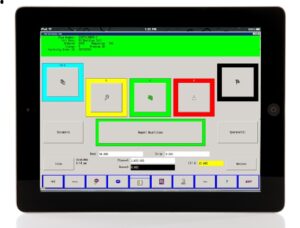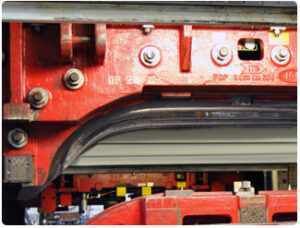Barcoding on the factory floor
What is the value of printing labels on demand?
In world class manufacturing, there is a difference between barcode printing and barcode reading, although many times they are used in the same breath and therefore, unfortunately in the same “factory data collection” project. The need for barcode printing is still a reasonable and valid approach to control inventory identification. However, using barcode scanners to read important data on how efficiently your factory is operating is outdated, to say the least.
Across the globe, top manufacturing companies are replacing their barcode scanners with touch screen windows and browser based Manufacturing Execution Systems (MES) which go well beyond simple factory data collection. The reasons for this change are both operationally and financially attractive.
 tive language of the production facility). In some cases, they do not even have the ability to read,” said John Leibert, President, FACTIVITY. “A good MES touch screen system will not require the operator to be able to read. It is simply a rote process of identifying buttons (often enhanced with flashing for focus) and pushing them like you would at an ATM or better yet the type you see servers use in restaurants.”
tive language of the production facility). In some cases, they do not even have the ability to read,” said John Leibert, President, FACTIVITY. “A good MES touch screen system will not require the operator to be able to read. It is simply a rote process of identifying buttons (often enhanced with flashing for focus) and pushing them like you would at an ATM or better yet the type you see servers use in restaurants.”
“Additionally, barcode labels can get smudged easily or partially destroyed and make its data ineffective,” Leibert said. “This type of cumbersome activity is the last thing you need for optimal shop floor control.”
Reading vs. printing
When looking into a “barcoding” solution for your factory floor, make sure you and your team differentiate between the need for “readers” and the need for “printers.” The need for bar printed labels on inventory parts, containers, boxes, binds, skids, etc. still exists – but it’s important to remember that the requirement for operators to track production no longer requires barcode “readers.”
These devices are normally associated with old fashion paper-based barcoded work sheets. The paper based “travelers” which allowed the operational work-in-process tracking of labor time, quantity completions, scrap reporting have been changed. The wasted time and waste in paper is not a sustainable approach and has been replaced by a newer world class manufacturing “paperless” interactive factory focused approach of real-time WIP management.
Cost savings
In addition, to saving paper, there is a major cost benefit to eliminating barcode readers on the factory floor in exchange for simple PC or windows based devices. The cost of RF readers can be in the range of $2,000 to $2,500 per station; whereas a standard chassis PC workstation or tablet replacement can cost less than half this amount.
Additional Benefits
Using a PC workstation or tablet also allows a manufacturing company to easily collect additional information which might be difficult or impossible with an RF reader. For example, capturing production metrics like OEE (Overall Equipment Effectiveness) can be facilitated by connecting the PC floor workstations to the floor assets (machines, lines, cells) to allow data acquisition. In this sense, they are like an HMI (Human Machine Interface). This is simply not available using an RF reader. In addition, quality data capture might also be helped by connecting the PC to weight scales, micrometers, and other measuring devices which again cannot be attached to bar code readers.
However, there is certainly a place for bar code printing driven from the PC on the factory floor. A good MES – using PC and Tablets as the only operator interface for production recording and labor time tracking – can facilitate production reporting using visual alerts and flashing buttons to help focus the operator in the data collection process and provide error proofing along with it. In addition, as production is recorded on the touch screens, labels can be printed on demand to help improve efficiency and productivity as in the example of Earn-a-Label programs.
Earning the label
Some companies have even taken barcode printing to a newer production reporting approach known as “Earn-a-Label.” This method ties a specific part quantity to an operator metric of simply recording good production in such a way that s/he can “earn” the right to label the goods produced.
 A good example of this can be seen at American Trim based in Lima, Ohio. A leading provider of metal components for the appliance, heavy truck and automotive industries, American Trim has been using FACTIVITY’s Shop Floor Workbench MES software since the mid-1990s. The company partnered with FACTIVITY to enhance the software with an “Earn-a-Label” system that requires operators to report production in order to print a label.
A good example of this can be seen at American Trim based in Lima, Ohio. A leading provider of metal components for the appliance, heavy truck and automotive industries, American Trim has been using FACTIVITY’s Shop Floor Workbench MES software since the mid-1990s. The company partnered with FACTIVITY to enhance the software with an “Earn-a-Label” system that requires operators to report production in order to print a label.
 The system simplifies the process and lessens human mistakes. “The earn-a-label discipline has eliminated batch printing of labels prior to production, which has greatly reduced customer mislabeled product,” said Paul Pellegrini, Director of IT, American Trim. “Prior to implementing ‘Earn-a-Label’ we were experiencing several customer rejects per year due to mislabeled product. In the past three years there has only been one reject due to mislabeling where we have Earn-a-Label in place.”
The system simplifies the process and lessens human mistakes. “The earn-a-label discipline has eliminated batch printing of labels prior to production, which has greatly reduced customer mislabeled product,” said Paul Pellegrini, Director of IT, American Trim. “Prior to implementing ‘Earn-a-Label’ we were experiencing several customer rejects per year due to mislabeled product. In the past three years there has only been one reject due to mislabeling where we have Earn-a-Label in place.”
When an operator reports production in FACTIVITY, an appropriate label is printed, based on the job being reported.
“FACTIVITY provides immediate and streamlined communications,” Pellegrini said. “It has helped us to improve inventory and labor reporting accuracy and is very easy for those on the shop floor to use.”
